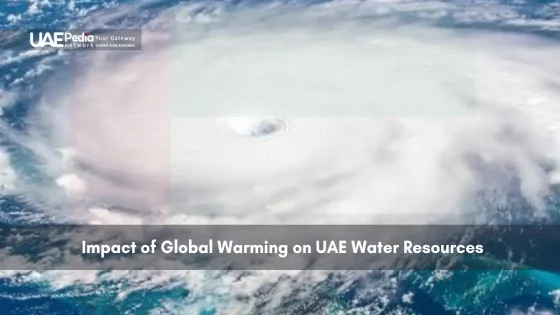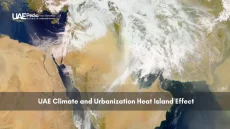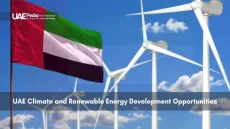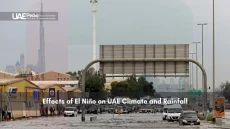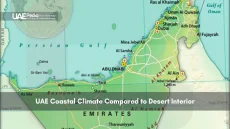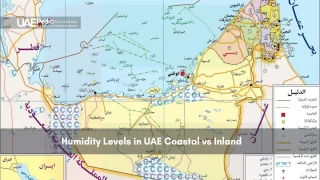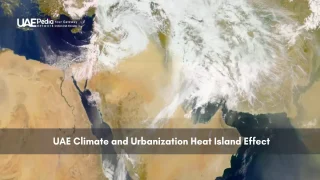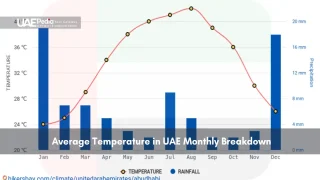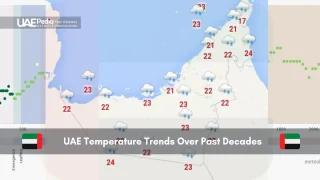Did you know the UAE’s iconic dunes have been reshaped by over 70 years of sudden downpours and hailstorms? While sun-soaked beaches and endless blue skies define its postcard image, the region’s climate history reveals a more dynamic story—one where intense rains occasionally rewrite the rules.
From flash floods rushing through wadis in the 1990s to record-breaking hailstorms in Al Ain, these moments aren’t just anomalies. They’re clues to how climate shifts interact with the UAE’s unique geography. Cities like Dubai and Sharjah have adapted roads and drainage systems after past events, yet researchers warn that future rainfall could hit harder and faster.
What does this mean for residents and travelers? Imagine navigating streets transformed into temporary rivers or discovering mountain trails altered overnight. Understanding these patterns isn’t about fear—it’s about preparing wisely while marveling at nature’s power in a land where desert meets innovation.
Key Insights:
- 70+ years of recorded weather shifts show unexpected trends in storm intensity
- Flash floods and hailstorms have repeatedly tested urban infrastructure
- Climate models suggest wetter extremes could reshape future planning
Historical Context and Climate Change in the Region
The UAE’s history isn’t just written in sand—it’s etched by unexpected deluges that have tested its cities time and again. Over seven decades, sudden storms have rewritten roads, challenged drainage systems, and revealed how desert landscapes interact with shifting weather patterns.
When the Skies Opened: Memorable Moments
In 1995, golf ball-sized hail pummeled Al Ain’s date farms, while 2003 saw Sharjah’s streets transform into rivers within hours. The 2017 Dubai downpour remains fresh in memory—over 270mm of rain flooded financial districts, halting metro lines. These weren’t isolated incidents but part of a pattern spanning 70+ years.
What triggers such chaos? Summer heat colliding with moist air from the Gulf creates explosive convective storms. Mountainous areas like Hatta amplify runoff, turning dry wadis into torrents. “Our data shows rainfall intensity increasing by 12% since the 1980s,” notes a National Center of Meteorology report.
Building Smarter, Not Just Higher
Each flood taught hard lessons. After the 2016 Ras Al Khaimah disaster, engineers redesigned highway slopes to redirect water. Dubai now uses AI-powered drainage sensors, while Abu Dhabi’s flood maps guide new construction. Communities in flood-prone areas receive emergency alerts via SMS—a system born from past close calls.
These adaptations matter beyond the Emirates. As global temperatures rise, arid regions worldwide face similar challenges. The UAE’s journey from reactive fixes to climate-resilient infrastructure offers a blueprint for balancing growth with nature’s unpredictability.
Investigating Extreme weather events in UAE: Trends and Implications
Let’s crunch numbers—because behind every flooded wadi and highway closure lies data telling a urgent story. Over the past decade, sensors across the Arab Emirates have recorded rainfall spikes that defy decades-old patterns. Take July 2022: Fujairah saw 278mm in 24 hours—triple its annual average—swallowing cars and shops alike.
Rain Gauges Don’t Lie—But They Do Surprise
Global studies reveal a 35% uptick in extreme rainfall intensity here since 2000. Why? Warmer Gulf waters pump more moisture into storm systems. A 2023 MIT-United Arab Emirates University joint study found these deluges now drop 22% more water per hour than 20 years ago. “It’s like nature’s firehose mode,” quips Dr. Amal Al-Haddad, lead meteorologist at NCM.
| Location | Year | Rainfall (24h) | Impact |
|---|---|---|---|
| Fujairah | 2022 | 278mm | 300+ vehicles stranded |
| Dubai | 2017 | 270mm | Metro suspension |
| Al Ain | 1995 | Hailstorm | Date farms destroyed |
Neighbors Feel the Squall Too
Oman’s 2021 cyclone and Saudi’s 2023 Jeddah floods mirror this trend. Urban planners now model flash floods using Dubai’s drainage upgrades as a template. Yet here’s the kicker: climate models predict 40% heavier downpours by 2040. Communities from Ras Al Khaimah to Abu Dhabi are rethinking everything from school closure protocols to mall basement designs.
“What was once a ‘once-in-a-century’ event now visits every decade. Adaptation isn’t optional—it’s survival math.”
Next time you dash through a parking lot during a surprise shower, remember—you’re witnessing history rewrite itself. The question isn’t if skies will break open again, but how we’ll dance in the rain when they do.
Assessing the Role of Climate Change and Forecast Uncertainties
Ever wonder why your desert road trip might suddenly turn into a splash zone? Warmer air holds more moisture—about 7% extra per 1°C rise—and the Gulf’s heated waters act like a turbocharger for storms. This isn’t sci-fi; it’s science. A 2023 study found summer downpours here now drop 25% more water per hour than in the 1990s.
When Predictions Play Hide-and-Seek
Forecasting these deluges? Think trying to photograph a cheetah mid-sprint with a 2005 flip phone. Even advanced models struggle with the UAE’s mix of mountains, coastlines, and sudden temperature swings. Cyclone Gonu (2007) caught Oman and the Emirates off-guard—it deflected 100km off predicted paths, causing $4B in damage.
The Data Dilemma
Why the guesswork? Convective storms here form faster than falcons dive. Sensors often miss their rapid development. Plus, sea surface temps fluctuate wildly—a 2°C spike can turn a mild shower into a flash flood maker. “We’re playing chess with nature,” admits a Dubai Met Department forecaster. “Every move counts, but the board keeps changing.”
So what’s next? Communities now treat forecasts as early warnings, not guarantees. Schools stock sandbags. Malls test underwater parking barriers. It’s resilience redefined—where preparation dances with uncertainty, one rain-soaked event at a time.
Infrastructure Vulnerabilities and Resilience Strategies
Picture this: you’re cruising down Sheikh Zayed Road when the sky cracks open. Within minutes, highways become rivers, and metro stations morph into waterfalls. These scenes aren’t movie plots—they’re real challenges faced by cities here. But behind the chaos lies a race to fortify the country’s bones against nature’s curveballs.
When Water Wins
Take March 2023. Dubai’s airport runway flooded, delaying 1,200+ flights. In Jebel Ali, water breached warehouse doors, damaging goods worth millions. Why? Concrete jungles struggle to absorb sudden deluges. Older drainage systems—built for lighter rains—overflow, turning low-lying areas into lakes. Even buried power lines face risks, as soggy ground destabilizes foundations.
Smart Solutions Rising
Here’s the twist: engineers now fight water with water. Abu Dhabi’s new retention ponds capture runoff for later irrigation. Dubai’s “Sponge City” project uses permeable pavements to soak up floods like a 700-hectare towel. The National Early Warning System texts alerts hours before storms hit—a lifeline for schools and delivery drivers alike.
- Drainage upgrades: 30% wider pipes in flood-prone zones since 2020
- Community drills: Sharjah’s annual “Rain Ready” workshops teach sandbagging
- Tech watchdogs: AI monitors 5,000+ storm drains 24/7
But resilience isn’t just concrete and code. It’s neighbors sharing umbrellas, shops offering shelter, and every person knowing evacuation routes. As one civil engineer put it: “We’re not just building walls against water—we’re weaving a safety net that holds.”
Response Efforts and Community Preparedness Initiatives
What happens when desert skies unleash their fury? Across the Emirates, a choreographed dance of sandbags, sensors, and solidarity springs to life. Last March’s record-breaking downpour saw Sharjah’s municipal teams deploy 800 water tankers in 12 hours—while Dubai residents formed human chains to clear storm drains. This isn’t just crisis management—it’s community symphony in action.
Public-Private Power Plays
Government alerts now ping phones hours before storms hit, advising remote work and school closures. Private giants like Emaar offer free home repairs through their “Rain Ready” programs. Even delivery apps join the effort—Careem delivered 15,000 emergency kits during 2023’s major squalls.
Tech plays backup singer here. The National Emergency Crisis Authority uses humidity trend data to predict trouble zones. “We’ve cut response times by 40% since 2020,” says Majid Al-Mansoori, a disaster management coordinator. “But the real heroes? Citizens reporting blocked drains via the ‘My Community’ app.”
Drains That Think & Streets That Drink
Urban planners are rewriting the rulebook. Dubai’s new Al Khawaneej district features “smart” drainage tunnels that widen automatically during heavy rains. Abu Dhabi tests asphalt that absorbs 3,000 liters per minute—like a thirsty camel gulping moisture.
| Innovation | Location | Impact |
|---|---|---|
| Permeable pavement | Dubai Hills | Reduces flooding by 65% |
| AI flood modeling | Sharjah | Predicts blockages 8hrs early |
| Community rain gardens | Ras Al Khaimah | Filters 90% of runoff |
“Preparedness isn’t about fighting nature—it’s learning to waltz with her surprises.”
Your role? Keep that emergency kit stocked. Share drainage updates with neighbors. And next time clouds gather, remember—you’re part of a world-class team turning chaos into coordinated action, one sandbag at a time.
Final Thoughts on Future Risks and Adaptive Preparedness
Imagine stepping off a plane at Dubai International Airport during peak travel season—only to find runways transformed into shallow lakes. Recent disruptions here and across the Gulf region remind us that yesterday’s infrastructure faces tomorrow’s storms. But there’s hope in the hustle: AI flood models now guide airport engineers, while Saudi Arabia’s climate resilience plans inspire cross-border collaboration.
Lessons from past rainfall events are clear. Cities must blend smarter tech with community grit—think neighborhoods adopting Dubai’s sandbag drills or Abu Dhabi’s AI-powered drainage alerts. Yet challenges linger. Forecast uncertainties still leave schools guessing about closures, and aging pipes in older districts remain vulnerable.
Here’s the good news: every disruption sparks innovation. From redesigned highway slopes to emergency SMS systems, the Emirates proves adaptation isn’t just possible—it’s already happening. Your role? Stay informed, support local preparedness programs, and champion green infrastructure projects.
The road ahead? Expect messier skies but smarter solutions. With data-driven strategies and a “fix it forward” mindset, this desert nation can turn future risks into resilience—one upgraded storm drain, one weather-aware community at a time.
While arid conditions dominate, historical records show rare but intense storms—like the 2016 Sharjah deluge that turned wadis into rivers. These events remind us the desert can surprise, though their frequency is shifting with global climate patterns.
Warmer seas near Abu Dhabi and Dubai fuel stronger convective systems—think "cloud bursts" that drop months of rain in hours. Studies suggest rising humidity and erratic jet streams may amplify these extremes, though regional forecasting remains a complex puzzle.
Low-lying zones like Dubai’s Business Bay or Al Quoz face drainage challenges during downpours. Mountainous regions near Ras Al Khaimah also see flash floods in wadis—a reason many hiking trails now have weather alert systems.
Post-2019 storms sparked major upgrades: Dubai’s deep tunnel stormwater network, Sharjah’s AI-powered flood sensors, and Abu Dhabi’s updated building codes. But balancing rapid urbanization with climate resilience remains an ongoing journey.
Absolutely—just pack patience! Monitor @NCMS_UAEEnglish for alerts. If skies open, embrace the spectacle (safely indoors). Many malls like Dubai Mall have rainwater diversion systems, and desert camps often pause operations until sand stabilizes post-storm.
From neighborhood WhatsApp groups sharing road closures to Dubai Police’s 4WD rescue units, responses blend tech and tradition. The National Emergency Crisis and Disaster Management Authority (NCEMA) coordinates drills nationwide—proof teamwork turns challenges into managed events.

